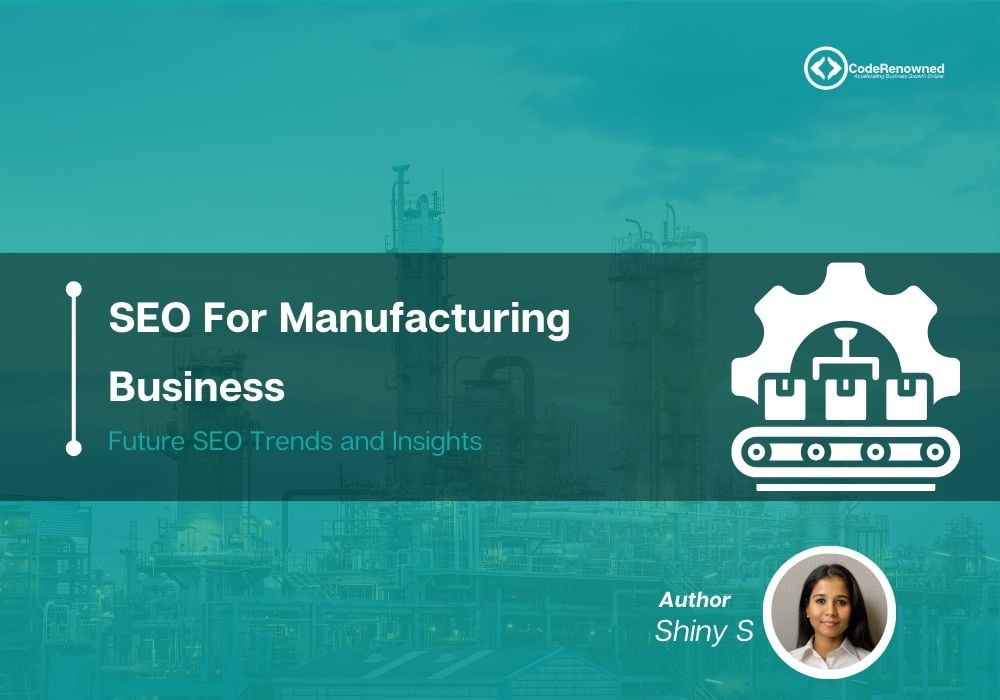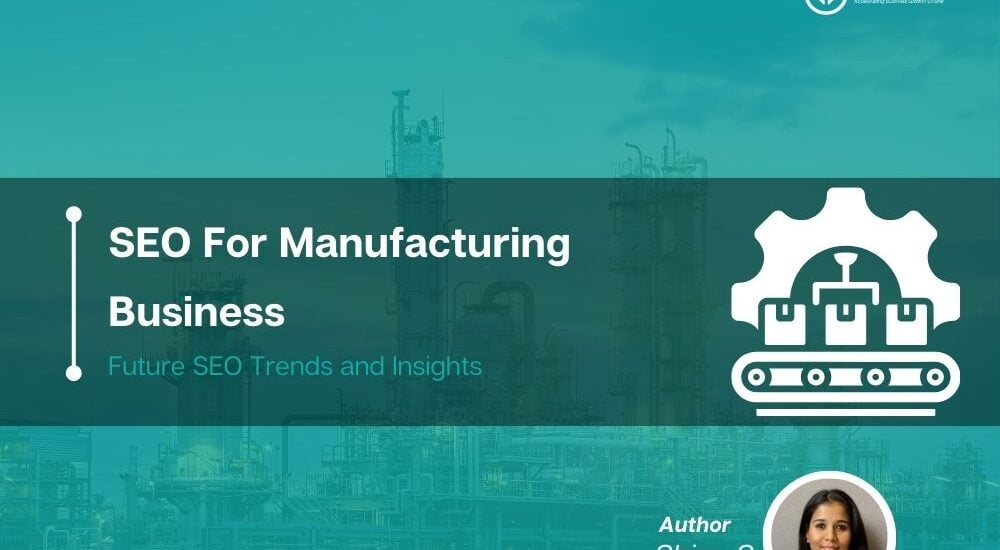SEO For Manufacturing Business
SEO Trends and Insights

Search Engine Optimization (SEO) unlocks unparalleled visibility, credibility, and growth opportunities. Let us delve into why SEO is crucial for manufacturing businesses in the digital age by enhancing online visibility to establishing authority in the industry by revolutionizing manufacturing enterprises to thrive.
Why SEO for Manufacturing Business?
- Increased Web Traffic: SEO helps the manufacturing site appear in front of potential customers on Billion Google Searches.
- More Qualified Leads: SEO targets the users searching for your products or services, leading to higher quality leads.
- Higher Customer Conversions: SEO can lead to higher conversion rates as it reaches a more targeted audience.
- Cost-Effective Marketing: Traffic from SEO after a high ranking is free, and it is a cost-effective strategy.
- Building Credibility and Trust: A good online presence through SEO can enhance credibility and trustworthiness.
- Long-Term Results: SEO provides endurable long-term results, unlike paid advertising.
SEO helps manufacturing companies become more visible online, attract traffic, and generate better leads, An essential component of a modern marketing strategy.
Know about Manufacturing SEO
Manufacturing SEO, also industrial SEO, is a specialized subcategory of search engine optimization tailored for manufacturing businesses. The fundamental principles of SEO apply across various industries, and this SEO focuses on optimizing digital support and content to cater to the needs and challenges of the sector. It involves strategies for on-page, off-page, and technical SEO tactics.
- On-page SEO includes optimizing title tags, meta descriptions, headings, URL structure, and image alt text with relevant keywords on the website and creating quality content to provide value and answer queries to visitors.
- Off-page SEO builds website authority through link acquisition from other reputable websites to establish credibility and rankings in search results.
- Technical SEO optimizes and helps search engines crawl and index the site more effectively by improving site speed, being mobile-friendly, and having a secure connection (HTTPS).
Utilizing industry expertise to create powerful content is crucial for Manufacturing companies that showcase unique manufacturing processes, products, and expertise. Optimizing for search intent assures that the content aligns with what users are searching for, leading to better engagement and conversion rates.
These strategies can enhance the online presence and attract more traffic, leads, and revenue to the manufacturing business.
Are there any types of SEO for Manufacturing, and How does it work?
SEO is adaptable to the specific needs and goals of Manufacturers. Below are some types of SEO that can focus on:
- Technical SEO ensures the technical requirements, like optimizing site speed, mobile-friendliness, secure connections (HTTPS), and clean site architecture for improved rankings.
- Local SEO: is for local businesses and customers by optimizing for Google Business Profile and ensuring the businesses appear in local Search, directories and maps.
- National SEO: Focuses rankings for keywords integral for manufacturers to serve a broader market on a national level.
- E-commerce SEO helps to sell products directly online by improving visibility and rankings on e-commerce platforms and search engines.
- Content SEO is creating and optimizing content like blog posts, product pages, and educational resources to attract and engage potential customers to rank for specific, industry-related keywords.
- Mobile SEO ensures website optimization for mobile users for a seamless experience across all devices.
Each SEO serves a different purpose but works together to improve an online presence to attract more traffic and generate leads
Impact of Manufacturing SEO Online:
Business-to-business buyers were unwilling to buy manufacturing products online earlier. But now, Research from Master B2B from more than 100 B2B buyers, Half of all buyers say more online in 2023. And 82% are projected to buy more online in 2024.
In the 2023 State of B2B Buyer Report by Master B2B, 27% of manufacturing parts buyers switched to buying online to save time. 21% of respondents mentioned they wanted more and better information on products and services. For 20%, 24/7 website access. And 16% say online purchases are easy to track for record, and 13% to save money.
- 57% of B2B marketers remarked that SEO generates more leads than any other initiative.
- 79% of manufacturers assert to have an SEO strategy.
- SEO drives over 1,000% more traffic and is the highest quality source of leads for 60% of marketers.
- By 2025, The global SEO services market may reach $103.24 billion at a compound annual growth rate of 20%.
- 84% of Manufacturers have increased their marketing budget after 2020 and spend 1-3% of their revenue on marketing.
- 69% of leads are from organic leads to manufacturing companies.
Manufacturing SEO: How to Get Started?
An Interactive Website
An interactive website can enhance Manufacturing SEO by engaging users and increasing time, a positive signal for search engines.
In the 2023 State of B2B Buyer Report by Master B2B, 27% of manufacturing parts buyers switched to buying online to save time. 21% of respondents mentioned they wanted more and better information on products and services. For 20%, 24/7 website access. And 16% say online purchases are easy to track for record, and 13% to save money.
Interactive Elements for Manufacturing Websites:
- Allow customers to customize products.
- Showcase products and facilities to offer a deeper understanding.
- Enable users to estimate the potential return on investment.
- Present complicated data in an engaging format.
- Provide support and answer visitor questions instantly.
- Help users identify their needs and solutions.
- Encourage reviews and testimonials, and combine social media to build trust and engagement.
Establish your SEO baseline:
SEO baseline is necessary for the current search engine visibility, identifying areas for improvement, and measuring the effectiveness of SEO efforts over time.
Website Audit:
- A complete website audit evaluates factors like site structure, URL hierarchy, page speed, mobile-friendliness, and technical SEO elements like meta tags, headings, and schema markup.
- Tools like PageSpeed Insights, Google Search Console, and SEO auditing software identify issues or areas for optimization on its current SEO performance.
Keyword Analysis:
- Analyze keyword rankings to decide which keywords currently rank for and their improvement.
- Tools like Google Keyword Planner, SEMrush, or Ahrefs identify relevant keywords and assess search volume competition and opportunities for high-value keywords.
Competitor Analysis:
- Analyze the SEO performance of the competitors to evaluate factors like keyword rankings, backlink profiles, content strategy, and website optimization.
- Identify which competitors outrank in search results and analyze their strategies.
Traffic Analysis:
- Google Analytics Tool analyzes website traffic and user behavior to identify metrics like total organic traffic, traffic sources, bounce rate, average session duration, and conversion rates.
- Understand user interaction to identify areas for improvement and Put SEO efforts to increase traffic and engagement.
Backlink Profile:
- Assess the quality and quantity of backlinks to measure the authority and credibility of the website in search engines.
- Tools like Link Explorer, Ahrefs, or Majestic analyze the backlink profile to identify high-quality backlinks from authoritative websites.
- They identify opportunities to gain new backlinks through outreach, content marketing, or guest blogging.
Content Analysis:
- Evaluate the quality of the content to analyze content depth, uniqueness, relevance to target keywords, and user engagement metrics of the website.
- Identify outdated content, optimize for target keywords, or create new content to fill gaps in the content strategy.
Tips to Improve Manufacturing SEO:
- Develop content that highlights the products, processes, and expertise.
- Ensure the website is fast and easy to navigate.
- Have a responsive design for the increasing usage of Mobile devices.
- Earn quality backlinks to boost the site’s authority and rankings.
Manufacturing SEO Trends and Insights :
- The increasing usage of smart speakers and virtual assistants expect optimizing the content for voice search queries.
- Focus on conversational keywords and long-tail phrases that imitate natural language.
- Google’s focus on E-A-T signals continues to grow. Manufacturing websites need to establish by publishing high-quality, authoritative content, showcasing expertise, and building trust with the audience.
- Visual search technology allows to search for products using images rather than text.
- Ensure the website is mobile-friendly, loads quickly, and gives a seamless user experience across all devices.
- Focus on improving site navigation, reducing bounce rates, and providing a smooth, instinctive browsing experience for users.
- Create product demos, how-to guides, and behind-the-scenes videos to showcase your expertise and attract potential customers.
- Provide clear, straightforward answers to common manufacturing-related questions to increase visibility and organic traffic to the website.
- Optimize the content around endurable manufacturing practices and eco-friendly products that attract environmentally-conscious customers and improve the brand image.
- Include AI-driven tools for SEO analysis and optimization to provide valuable insights and improve campaign performance.






